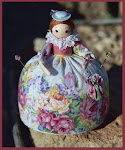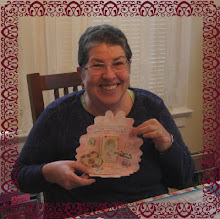 The crazy quilting part of the beret:
The crazy quilting part of the beret: Starting with a vintage Vogue pattern, 9094, which I purchased a long time ago for $2! I made it up several years ago, in wool. It was a tiny bit too small, so I enlarged the pattern, using my printer, up to 105% of original.
Starting with a vintage Vogue pattern, 9094, which I purchased a long time ago for $2! I made it up several years ago, in wool. It was a tiny bit too small, so I enlarged the pattern, using my printer, up to 105% of original.
I divided the top of the beret pattern into four sections. It seemed less frightening to create a crazy patchwork when I broke it into several sections. I then drew and colored in a patchwork design in each quarter section, lapping some of the pieces over into the next quarter so it wouldn’t look quite so contrived. I know this defeats the improvisational nature of crazy patchwork, but improvisation is not a strong point of mine. (I enjoy being inside the box, it’s cozy and comfortable in there!)
The patchwork design was traced onto a loosely woven background fabric and then onto lightweight fusible interfacing:
 Cut the pieces of the interfacing and lightly fuse them to the back of velvet scraps. Trim around the interfacing, leaving 1/8” extra all around. I don’t cut all the pieces at once, it could get difficult to figure out where they fit into the crazy patchwork puzzle.
Cut the pieces of the interfacing and lightly fuse them to the back of velvet scraps. Trim around the interfacing, leaving 1/8” extra all around. I don’t cut all the pieces at once, it could get difficult to figure out where they fit into the crazy patchwork puzzle.
Pin the cut pieces to the background fabric, overlapping over each other by 1/8":
 Machine baste the patchwork pieces to the background fabric, using a long zigzag stitch, and attaching each piece to its neighbors. Here it is with the zigzag basting completed:
Machine baste the patchwork pieces to the background fabric, using a long zigzag stitch, and attaching each piece to its neighbors. Here it is with the zigzag basting completed: I used Sulky invisible thread for the machine basting. It would be impossible to match the thread to the fabric pieces, and the invisible Sulky worked very well in my sewing machine, with invisible thread on the top and a cotton/poly thread in the bobbin. I also used Sulky invisible for attaching the beads after the embroidery was completed. Some sewers do not like to use this product, but I use it often and have a good trick for making it a little less frustrating. Because the thread slips out of the needle very easily, I tie a surgeon’s knot right at the needle. This holds the slippery thread in the needle and it goes through any kind of fabric easily. You have to move the knot up as the thread length gets shorter.
I used Sulky invisible thread for the machine basting. It would be impossible to match the thread to the fabric pieces, and the invisible Sulky worked very well in my sewing machine, with invisible thread on the top and a cotton/poly thread in the bobbin. I also used Sulky invisible for attaching the beads after the embroidery was completed. Some sewers do not like to use this product, but I use it often and have a good trick for making it a little less frustrating. Because the thread slips out of the needle very easily, I tie a surgeon’s knot right at the needle. This holds the slippery thread in the needle and it goes through any kind of fabric easily. You have to move the knot up as the thread length gets shorter. Margot situated herself in my box of embroidery threads and beads. I put them in the box so she wouldn’t knock them off the table! Oh well.
Margot situated herself in my box of embroidery threads and beads. I put them in the box so she wouldn’t knock them off the table! Oh well.
Detail of some of the embroidery stitches:

I love my old Coats & Clark “100 Embroidery Stitches” booklet. It’s the best! It was fun to explore some stitches I had not used in years. You can still find this earlier version of the booklet (and a newer one) on EBay, Amazon, etc., but not for 35¢!

Embroidery don'ts: It was a real challenge to work some of the embroidery on the piece. I don’t think I will do another crazy quilted project using velvet. Too thick (sometimes there were 3 layers of fabric to go through, two of velvet and one background fabric). In some places I had to use pliers to get the needle through the layers! Also, I like to use materials that I have on hand, and I have a small box of embroidery threads collected and partially used over the years. Very neatly organized into colors, a little baggy of reds, another of yellows, etc. Unfortunately, the quality of these old scraps of threads was inconsistent! Only one skein of floss I used was perfect, like gliding the thread through butter. This was a new skein of DMC variegated floss, the gold in the lower left corner. Next time, all new threads!
 Next post, finishing the beret.
Next post, finishing the beret.
















No comments:
Post a Comment